Beihai Park (North Sea Park), approached by four gates and just north-west of the Forbidden City, is the former pleasure ground of the Emperors. It is now one of the oldest and most authentically protected imperial gardens in China.
The park covers an area of 71.4 hectares, half of which is a lake. The island in the lower middle is composed of heaped earth dug to create the lake - some attribute this to the handiwork of Kublai Khan. The site is associated with the Great Khan's Palace, the belly-button of Beijing before the creation of the Forbidden City.
All that remains of the Khan's court is a large jar, made of green jade, in the Round City near the south entrance. A present given in 1265, and said to contain the Khan's wine, it was later discovered in the hands of Taoist priests who used it to store pickles. In the Light Receiving Hall, the main structure nearby, is a 1.
5 meters high white jade Buddha inlaid with jewel - a gift to Empress Dowager Cixi, from Burma.
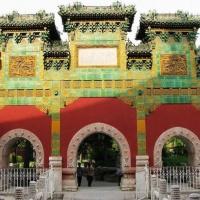
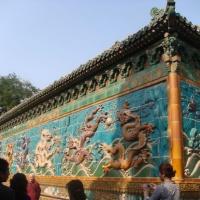
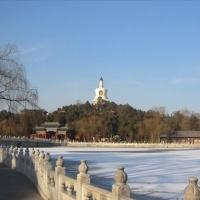
From the 12th century on, Beihai Park was landscaped with artificial hills, towers, bridges, pavilions, halls, temples and covered walkways - culminating in the present era when the structures were massively restored. It is one of the best examples of a classical garden now found in China.
 Dominating Jade Islet on the lake is the White Dagoba, a pop-art "Peppermint Bottle" about 36 meters high, built in 1651 to commemorate the visit of a Dalai Lama, and rebuilt in 1741. It is believed that Lamaist scriptures, robes and other sacred objects are encased in this brick-and-stone landmark. On the north-east shore of the islet is a handsome double-tiered painted gallery - unusual architecture for a walk way. Near the boat-dock here is the Fangshan Restaurant, dishing up recipes favored by Empress Cixi; she liked 120-course dinners with about 30 kinds of desserts. Expensive, high class, reservation only (but check out the d cor!) - off to one side, however, is a snack bar that dispenses royal pastries, much cheaper.
Dominating Jade Islet on the lake is the White Dagoba, a pop-art "Peppermint Bottle" about 36 meters high, built in 1651 to commemorate the visit of a Dalai Lama, and rebuilt in 1741. It is believed that Lamaist scriptures, robes and other sacred objects are encased in this brick-and-stone landmark. On the north-east shore of the islet is a handsome double-tiered painted gallery - unusual architecture for a walk way. Near the boat-dock here is the Fangshan Restaurant, dishing up recipes favored by Empress Cixi; she liked 120-course dinners with about 30 kinds of desserts. Expensive, high class, reservation only (but check out the d cor!) - off to one side, however, is a snack bar that dispenses royal pastries, much cheaper.
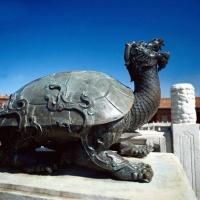 From this point you can catch a barge to the north-west part of the park, or, if energetic, double back and rent a rowboat and propel yourself over there (there's another rowboat on the north-west side). The attraction on the north side is the Nine Dragon Screen, five meters high and 27 meters long, made of colored glazed tiles - one of the three famous ones in China, and in good shape. The screen's function was to scare off evil spirits - it stands at the entrance to a temple which has disappeared. To the south-west of the boat-dock on this side is the Five Dragon Pavilion dating to 1651, where the Emperors liked to fish or camp out at night to watch the moon.
From this point you can catch a barge to the north-west part of the park, or, if energetic, double back and rent a rowboat and propel yourself over there (there's another rowboat on the north-west side). The attraction on the north side is the Nine Dragon Screen, five meters high and 27 meters long, made of colored glazed tiles - one of the three famous ones in China, and in good shape. The screen's function was to scare off evil spirits - it stands at the entrance to a temple which has disappeared. To the south-west of the boat-dock on this side is the Five Dragon Pavilion dating to 1651, where the Emperors liked to fish or camp out at night to watch the moon.
On the east side of the park are the "gardens within gardens". These waterside pavilions, winding corridors and rockeries were summer haunts of the imperial family - notably Emperor Qianlong and Empress Cixi. They date back some 200 years, with structures like the Painted Boat Studio and the Studio of Mental Calmness - until 1980 the villas were used as government offices.
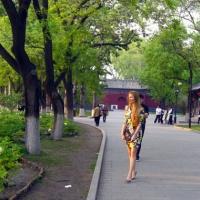 Beihai Park is a relaxing place to stroll around, grab a snack, sip a beer, rent a rowboat - or, as the Chinese do, neck on a bench in the evening (or dive into the lake when on-one's around - swimming is not permitted). In winter there is skating. Nothing is new in China - skating apparently goes back to the 18th century when Emperor Qianlong reviewed the imperial skating parties here. The park is open daily 6 am to 11 pm summer and 7 am to 8.30 pm winter.
Beihai Park is a relaxing place to stroll around, grab a snack, sip a beer, rent a rowboat - or, as the Chinese do, neck on a bench in the evening (or dive into the lake when on-one's around - swimming is not permitted). In winter there is skating. Nothing is new in China - skating apparently goes back to the 18th century when Emperor Qianlong reviewed the imperial skating parties here. The park is open daily 6 am to 11 pm summer and 7 am to 8.30 pm winter.
To get to the Beihai Park, you can take bus line 101, 103, 109, 124, 812, 814, and 846 to reach its south gate; line 13, 107, 111, 118, 701, 810, 823 and 814 to reach the north gate; line 810 and line 5 to reach the east gate.
